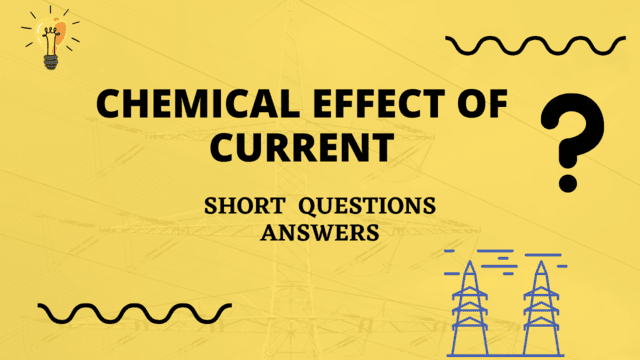CHEMICAL EFFECTS OF ELECTRIC CURRENT: PHYSICS SHORT ANSWER QUESTIONS
CHEMICAL EFFECTS OF ELECTRIC CURRENT
Electrolysis:
Electrolytes:
Non–Electrolytes:
1. What is meant by the Chemical Effects of the Electric Current?
Ans: The phenomenon of decomposition of the electrolytes such as NaCl, AgNo3 into their respective ions by passing an electric current is called the chemical effects of current.
2. What is meant by an Electrolysis?
Ans: Electrolysis is the process of decomposition of an electrolyte into its own constituent ions by passing an electric current through it.
You can read more about electrolysis by clicking here...
3. What is known is Ionization?
Ans: The process of decomposition of the compound into its respective ions is called ionization.
4. What are electrolytes?
Ans: An electrolyte is a substance that produces an electrically conducting solution when dissolved in a polar solvent, such as water.
5. What are electrodes?
Ans: The metal rod or plates which are partially dipped in the electrolyte solution are called electrodes.
6. Distinguish between conductor and electrolytes.
Ans:
|
Conductor |
Electrolyte |
|
An object that allows the flow of electrical current in one or more directions. |
A substance that produces an electrically conducting solution when dissolved in a polar solvent, such as water. |
|
Eg: an electrical wire is a good conductor that can carries electricity along its length. |
Eg: NaCl is placed in water. According to the dissociation reaction, the salt dissolves into its component ions while mixing with water. |
You can view the more difference between Conductor and Electrolyte by Clicking Here...
7. What is a voltameter?
Ans: Voltammeter is a vessel in which electrolysis is carried out.
8. Why do electrolytes get dissociated when dissolved in a polar solvent or liquid?
Ans: Electrolytes dissociate when dissolved in liquid because when a voltage is applied to such a solution, the cations of the solution are drawn to the electrode which has an abundance of electrons, and similarly, anions are drawn to the electrode which has a deficit of electrons.
9. What is the source of emf?
Ans: The source of the emf is the energy provided by the cell or a columb of charge passing through it.
10. State Faraday's Law of Electrolytes?
Ans:
First law of electrolysis: It states that the mass of the substance liberated or deposited at the electrode in the electrolysis process is proportional to the quantity of electric charge passed through the solution(electrolyte or system).
Then m α Q
Or, m=ZQ where (Z= proportionality constant) Z is the electrochemical equivalent of the given substance.
Or, m=ZIt where Q=It
Second law of electrolysis: It states when the same amount of electric charge passes through a different solution (electrolyte or system) then the mass of the substance deposit or liberated at the electrode is directly proportional to their chemical equivalents.
Then we have
m1E1=m2E2=m3E3=m4E4=m5E5
or, mE=aconstant
11. What is meant by the electrochemical equivalent of substance?
Ans: Electrochemical equivalent of the substance is defined as a mass of the substance deposited or liberated on an electrode when one coulomb of charge flows through its electrolyte in a specific medium.
12. What is meant by the chemical equivalent of a substance?
i.e = MV
13. What is Faraday's constant?
Ans: Faraday’s constant is defined as the amount of charge requires by depositing or liberating one mole of monovalent substance during electrolysis. The approximated value of Faraday’s constant is equal to 96500 C/mole.
Where F= faraday’s constant
E=chemical equivalent of the substance
Q=charge and m=mass of deposit or liberate.
14. Define 1 Faraday.
Ans: 1 faraday is defined as the quantity of charge flowing through an electrolyte that will liberate 1 gram-equivalent of any substance at each electrode.
15. What is an electric cell?
Ans: An electric cell is a device that is used to produce electricity through the chemical reaction
16. Differentiate between primary and secondary cells?
Ans:
|
Primary cell |
Secondary cell |
|
All the chemical reaction performed is irreversible. |
All the chemical reactions performed are reversible. |
|
They can't be recharged. |
They can be recharged. |
|
These cells have high internal resistance. |
These cells have low internal resistance. |
|
A high Ampere of current is not obtained. |
A high Ampere of current can be obtained. |
17. Why is a secondary cell called an accumulator?
Ans: Secondary cell is called an accumulator because it stores the electrical energy in the form of chemical energy and when the outside circuit is closed the current is generated by converting the chemical energy into electrical energy.
18. What do you mean by the capacity of a cell?
Ans: The capacity of the cell is defined as the ratio of ampere per hour discharge to the ampere per hour charge or the ratio of the energy given at the discharge to the energy given at the charge.
19. What do you mean by charging and discharging a cell?
Ans: The cell is said to be charged if it is connected to the opposition to the supply of the greater emf and the cell is said to be discharged if its terminals are connected to the external resistance.
20. What is the function of porous pot in primary cells?
Ans: The function of the porous pot is to separate the solution and to complete the circuit by allowing the ions to pass through it.
Thank you so much for being up to here, you can also view our other very knowledgeable posts by clicking here at FREEBIE SOLUTIONS.
- Kinematics: Physics short answer questions
- Wave Motion: Physics Short Answer Questions
- Lewis concept of Acid and Base
Also, don't forget to comment with your generous feedbacks and also mention which topic our next post should be which will be beneficial for you guys.


Comments
Post a Comment
Please, do not enter any spam links in the comment box.